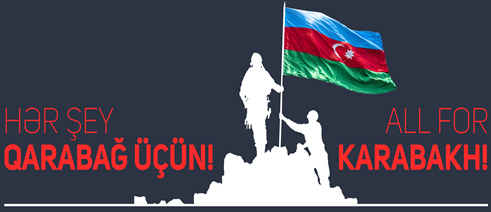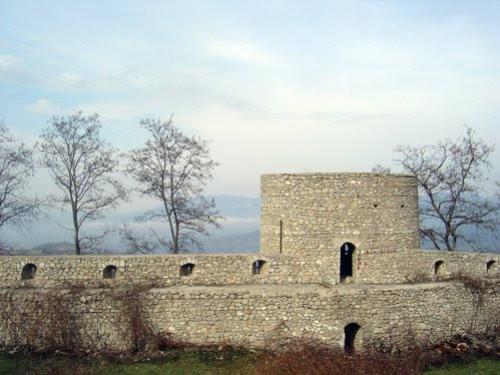


Kharabakh region of Azerbaijan is the area where people lived in 2 million year old Azikh Cave, one of the most ancient human residences. The area of Karabakh is a residence of successors of substituting Kura-Araz and Khojaly-Gadabay cultures which existed in the Bronze and Iron Ages of Paleolithtic period of Guruchay culture founders.
The ancient stone monuments discovered in mountainous and plain areas of Karabakh- dolmens in Khojaly, kromlekhs in Khankandi, as well as, stone box graves of ancient times discovered in different places of Karabakh are material culture signs reflecting ideology, moral thinking of that period.
In the whole territory of Azerbaijan among Manna , Atropatena,Skit states in the junction of IV-III centuries BC Caucasian Albania appeared in the territory of the Azerbaijan Republic. Albania was governed by Albanian Arshakis family in I century. The southern boundary of Albania was along the Araz River (History of Albania by Moisey Kalankatuglu (translated by Ziya Bunyadov), Science , Baku-1993, 235 pp book1, ch.4; History of Armenia (translated by N. Gmina) Science, Moscow 1983 , book 2 ch. 8) Girdman, Sakasena, Uti, arsak, Paytakaran, Sisakan were historical lands of Kharabakh. (History of Albania by Moisey Kalankatuglu (translated by Ziya Bunyadov) , Science , Baku 1993 235 pp book 4, ch. 50; Azerbaijan History, Vol II, Science, Baki, 1998 pp. 15-21)
A great number of Scythian burial mounds of Turkic peoples dating back to VI-III centuries BC were discovered in Beylagan, Aghjabadi, Barda, Yevlakh, Tartar and upland area of Karabakh.
The ancient sources bear interesting information about the existence of old towns in ancient territoru of Karabakh- Uti, Arsak, and Paytakaran. Archaeological researches made in Barda, Govurgala ( Aghdam), Garakopek Hill (Fuzuli), Ergi settlement (Aghjabadi),etc approve the above- mentioned statements. Besides archeological monuments, a number of Christian monuments were investigated in Karabakh region. These monuments were met in Barda, Aghjabadi, Aghdam, Fuzuli, Aghdere areas of Karabakh as well as in Lachin and Kalbajar. The most popular of these monuments Ganjasar (Ganzasar), Amaras, Elysian and Khotavang temples. It should be noted that Albanian Christian monuments also exist in other areas of Azerbaijan (Gabala, Nakhchivan, Mingachevir, Gazakh, Tovuz, Shamakhi).
By the way, there was no ethnic mass in Nagorno Karabakh up to XIX century. Beginning from XIX century many Armenain families were remitted to Karabakh by making use of avtokhton Albanians living there.
The monument erected by Armenians in Maragha village of Aghdere (Mardakert) in Karabakh in 1978 in the honor of eviction of first 200 Armenian families (from Maragha city of Iran) to Karabakh proves it.
The existence of different religions had a great impact on the social life of human society. The existence of Islam and Christianity and their substitute of each-other in Karabakh as well as in every part of Azerbaijan showed itself in the building culture . A good deal of Albanian Christian monuments were built in the area of Karabakh ( Amaras in Nagorno-Karabakh, Govurgala in Aghdam, Khotavang in Kalbajar, Aghoghlan in Lachin) and other places of Albania (Gum village of Gakh region, Big Amidli village of Gabala region, Mingachevir).
There existed all kinds of architecture particular to East Christianity in Albania. Albanian cross stones form their specific group obeyed to laws of religious art with their local features and reflection of faiths and forces of universe till Christianity on Albanian written stones. Albanian cross bears signs which sum up indications of beliefs and universe cognition till Christianity. Its all compositions are reflected like links across the sky to the ground, symbol of sun, light, and fertility.
The adoption of Islam was the beginning of a new stage in Albania (Azerbaijan). During Islam many mosques and minarets were built in Garabagh, part of Azerbaijan. Along with it, Christian churches and other religious temples were protected there.
In that period flourishing period started in spiritual culture of Karabakh. In this land dozens of prominent thinkers with nicknames “ Karabakhi”, “ Bardai” grew up, information about their names, personalities and literary activities have become part of history.
In the period when Shirvan-Absheron, Nakhchivan-Maragha schools, which reflect main directions of architecture in XI-XII centuries, were widely spread, Arran (Karabakh) architecture school defines the further progress of Azerbaijan culture of Middle Ages. Architecture and town-building, decorative applied art beagan to develop in this period, the number of epigraphic monuments increased. More than 2000 different historical and cultural monuments mostly of Islam period were registered. There are houses, public buildings, as well as religious buildings, places of visit among them.
The cities of Karabakh – Aghdere, Kalbajar, Khojavand, Shusha, Khankendi, Tartar, Fuzuli, Jabrayil, Aghjabadi, Lachin, Gubadli, Zangilan appeared in the period of Islam. The national, moral, and ideological thinking style in the structure of these cities was artistically reflected in the building culture. New national ideological features show themselves in the interiors of houses and administrative buildings. It is proven with architectural masterpieces built in Middle Ages all over Azerbaijan, as well as Karabakh.
A number of cultural monuments of different kinds were registered in the area of Karabakh, and the majority of them are epigraphic monuments. A considerable number of building, tombs, and epigraphic ,etc. monuments were registered and investigated in the areas of Shusha, Aghdam, Barda, Fuzuli, Zangilan, Jabrayil, Lachin, Kalbajar regions.
Sheykh Yaqub’s Tomb (Sepulcher) in Fuzuli (XII century), Qoch Ahmadli Juma Mosque, Haji Alasgar Mosque, Mir Ali tomb ( sepulcher) in Ashaghi Veysalli village ( XIV century) and tombs in Ahmadallar village (XIV century), Sheykh Ibrahim Tomb (XVII century) Ahmad Sultan Tomb, Jalal Tomb (h.c. 1307) Juma Mosque in Horadiz village, Asgaran fortress in the area of Nagorno Karabakh, Maiden Tower in in the region of Jabrayil, a tomb in Shikhlar village of Jabrayil (1308) and other tombs, a 12 cornered tomb near Khachin Darband village in Aghdam, Aghdam Juma Mosque (1870) , a bath building in Abdal – Gulabli village of Aghdam ( beginning of XX century) , Shahbulag Mosque of Aghdam, a 12 arched bridge Tartar river in Barda (XIV century), “Barda” , “Akhsadan baba” tombs (XIV century), a double minaret “Imamzadeh” mosque complex built in Barda by Karbalayi Safkhan Garabaghi (1868), “Bahman Mirze“ tomb, an eight angle tomb in Shusha, Penah khan fortress, Natavan’s house, Mamayi mosque, Mashadi Shukur Mirsiyab oghlu’s mosque caravanserai, Julfalar Mosque, Haji Yusifli Mosque, Saatli Mosque, Upper Govheragha Mosque, Down Govheragha Mosque (XIX century), Khan evi (house),the gymnasium building, Garasaggal tomb in Lachin, Soltan baba tomb, Sheykh Ahmad tomb, Sari Ashug’s tomb (XV century), tombs in Jijimli village, “Ushag galasi” (child fortress) in Gushchu village, “Boyuk bulag” (big spring) monument (XV century), Hamza Sultan palace (1761) are valuable material culture monuments for our history.
Bayat, Shahbulag (Tarnakut), Panahabad (Shusha) fortresses together bazaars, caravanserais, mosques, bath- houses,etc were built in the second half of XVIII century in Karabakh. Mansions, kumbezs belonging to Penah khan and his family were built in Aghdam.
Some fortresses (Bayat, Shahbulag, Panahabad (Shusha) were built, and settlements of a city and village type appeared during the period of Karabakh khanate. Beautiful and typical samples of wall paintings were created in the interiors of public buildings and houses in Shusha,the capital city of Karabakh khanate.
Most of these monuments form the main type of memorial buildings in Azerbaijan. There is no information about them since they are under occupation now.
Karabakh carpets which are popular since Middle Ages have kept their reputation so far. Carpets of Karabakh carpets group are distinguished with their names and decorative patterns. Karabakh carpets are divided into the first group with Barda , Aghjabadi carpets, into the second group with Shusha carpets, into the third group with Jabrayil carpets.
The ancient traditions were continued intensively in the carpet art of Karabakh. The art of Karabakh carpets centralized in Shusha from the second half of XVII century, later it developed on a large scale.
The culture, science , and literature went through the period of great progress in late Middle Ages in Azerbaijan, as well as Karabakh like in the east of all Moslem countries. In the following periods Karabakh didn’t lose its role of cultural centre.
Thus, researches display obviously that Karabakh material culture heritage is an integral part of Azerbaijan material culture and gives ground to prove that opposite ideas sounded about it lack reasons. Coming to the destiny of Karabakh monuments today, it must be mentioned that Armenia’s destructive work, war and conflict endangered them.
There was no opportunity to protect these monuments on the eve of the war. No chance was given to transfer museum exhibits and libraries. The ongoing vandalism destroyed most of the historical monuments that Azerbaijan had protected for centuries. People of Khojali were subject to the genocide by Armenian and Russian military units who caused the biggest tragedy of XX century Khojali tragedy. They destroyed the popular Khojali cemetry which was our great ancestors’ historical memory symbol with military technics. This vandalism of nasty enemies reached to its exreme level. Khojali mounds which were the ancient cradle of Khojaly- Gadabay culture were completely ruined. Azerbaijan thinkers’ monuments were fired with gun bullets in Shusha. The museums were destructed in Shusha.
The Azikh cave which was the world’s great ancestors’ cradle was changed into Armenians’ ammunition storage. Islam monuments were completely ruined. Albanian christian monuments were completely distorted. Albanian writings on Elysee temple, Hasanriz temple , and other monumets were wiped out. The items of these monuments which belonged to Albanians were destroyed. The Albanian ruler III Vachagan’s grave and writings on it which was protected in Elysee temple were completely ruined.
Gasim Hajiyev
Doctor of Historical Sciences